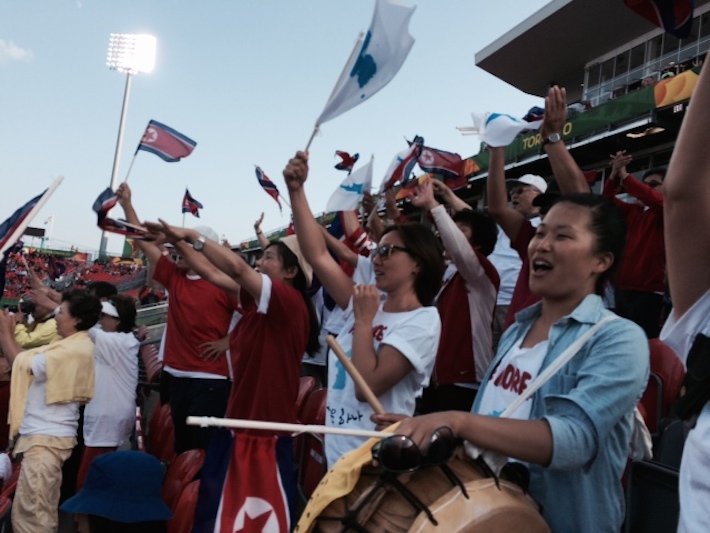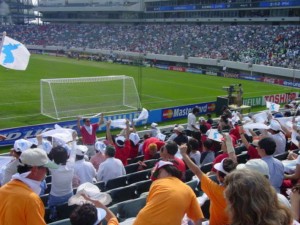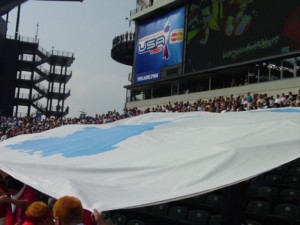
Korean Americans and Korean Canadians waving unification flags and playing Korean drums at the 2014 FIFA Women’s Under-20 World Cup in Toronto. (Photo: Betsy Yoon)
On a Tuesday in early August, North Korea’s women’s soccer team defeated Finland 2 to 1 in the opening match of the FIFA Women’s Under-20 World Cup in Toronto.
Yes, it was just a soccer game. But for those of us who were there to cheer on the North Korean team, the stakes were profound. International soccer fans routinely express their support by adorning themselves in the national colors and symbols of a single country. In our case, however, we came as the supporters of a peacefully reunified Korea.
Ranging in age from 27 to 80, a group of Korean Americans and Korean Canadians converged in Toronto for the game. Armed with flags and wearing t-shirts bearing images of a unified Korea, the group included nearly 50 grandfathers and grandmothers who had come from as far away as Vancouver, Texas, and Kansas. The backside of our t-shirts displayed the text of the 6.15 Joint Declaration, signed in 2000 by the leaders of North and South Korea, declaring their mutual desire for peaceful reunification.
Someone unfamiliar with Korea’s history might ask, why would a group of Korean immigrants travel so far to cheer on the North Korean women’s soccer team?
Rules of the Game
The Unification Flag had been openly displayed at international sporting events as early as 1991, when athletes from North and South Korea for the first time participated on a single team.
But even though the 6.15 resolution had been agreed to by both Koreas, a FIFA representative informed us during halftime that because Korea is currently recognized by the United Nations as two separate states, promoting the idea of a single Korea on our t-shirts and flags constituted a political statement, which FIFA prohibits at its events. “I understand. I’ve been to Korea myself,” he said over our protests. “But I warn you, if you don’t take off the shirts and stop waving the flags, I will have to call on guards to escort all of you out of the stadium.”

Korean Americans holding small unification flags at the 2003 FIFA Women’s World Cup. (Photo: Tongkyun Kim)
Fan support for Korean teams at international sporting events under the banner of one Korea was not, however, without precedent. In the 2003 FIFA Women’s World Cup hosted by the United States, Korean American fans unfurled a giant unification flag that covered an entire section of a Philadelphia stadium, with no admonition from FIFA. North and South Korea memorably marched under the Unification Flag in the 2000 and 2004 Summer Olympics, the 2006 Winter Olympics, and the 2006 Asian Games.
Presumably unaware of the use of the flag at past FIFA events, the FIFA official foisted responsibility for the decision onto the ironclad rules of the game, saying that he had no choice but to enforce them.

Korean American fans waving the Unification Flag at the 2003 FIFA Women’s World Cup in Philadelphia. (Photo: Tongkyun Kim)
For those of us supporting North Korea under the banner of a unified Korea, the division of Korea was not just political, but deeply personal. Many of the elderly members of our group were survivors of the Korean War who have been separated from family in the North. They have lived with unhealed wounds that stem from the unresolved war and Korea’s enduring division.
The Political is Deeply Personal
Coming to cheer on the North Korean team and to wave the Unification Flag was one way in which Noh Chunhee sought to redress the painful past. During the war, as her family was preparing to flee from the southern city of Daegu, a relative urged her parents to abandon Ms. Noh and her sister, the youngest of her parents’ many children. In the end, her parents did not leave the city, but this painful memory remains.
“My sister was 3 and I was 2, and my mother heard my sister saying something to her pillow, hugging it like a baby,” recounted Ms. Noh. “My mother leaned in to listen. She heard her saying, ‘They’re going to throw us away. They’re going to throw us away.’ Years later, when my older sister hears our mother tell this story, she still cries.” Now 64 years old, Ms. Noh, a New York resident, drove all the way to Toronto to see the match.
Cheering on the North Korean team until his voice turned hoarse, Soobok Kim was both haunted and galvanized by his memories of the war. “I was hit here,” he said, pointing to the sole of his foot, “Six years old, hit by a U.S. airstrike. Not only me, two sisters also.” Now 70, Kim gestured toward his foot and added, “And this, even though it looks OK now, I still ache every day when I walk.”
Our outraged response to FIFA was not simply a matter of asserting our right to free speech. FIFA’s demand was in effect a de-legitimization of the experiences of Koreans who had lived through the devastation of war and the externally imposed division of our homeland.
Our desire to cheer on the North Korean team under the banner of a peacefully reunified Korea was not “political” in a divisive or provocative sense, as FIFA implied. To the contrary, our actions were a necessary expression of hope for those of us who continue to believe in a resolution to the ongoing war and division, and the urgency of lasting peace in Korea.
Overcoming the Past
The scars of the past were not just present in the audience. When the teams from Finland and North Korea emerged onto the field, the significant height disparity was immediately noticeable: The Finnish team was strikingly tall whereas the North Korean team was uniformly short.
While this might not seem odd to the casual observer who likely carries a bleak vision of North Korean life, we recognized the height disparity as visible scars of a painful recent past. Born between 1995 and 1997, at the height of North Korea’s economic crisis, the North Korean soccer players were survivors of an especially bleak period marked by widespread food shortages, which North Koreans refer to as the “Arduous March.”
With the country’s fuel supply cut off due to the collapse of the Soviet Union and the socialist trading bloc, North Korea’s factory production came to an abrupt halt. Its idle tractors were transformed from tools for developing their country into immovable reminders of their changed reality. A series of floods and droughts devastated the country’s annual harvests, and U.S.-imposed sanctions blocked virtually all sources of income for the cash-strapped country. Among the many deprivations suffered by the North Korean people during this time, undernourished mothers were unable to breastfeed and did not have access to infant formula, so children born during the “Arduous March” possess a searing memory of hunger.
It was those children, now grown, who were representing their country on the world stage. If it were a contest based solely on size, the North Koreans would have stood no chance. But when the game opened, they ruled the field. They outran, outfought, and outscored the Finnish opponents who towered over them. In our minds, they became giants, criss-crossing the field with stunning speed and power, gritting their way to pulling off a herculean feat that seemed implausible just moments before.
A Step Toward One Korea
Outraged by FIFA’s denial of our right to claim our nation as one and exhilarated by the tough determination of the North Korean team, we chanted the name of the last united Korean kingdom: “Joseon! Joseon!”
With each goal, our chants became more impassioned and our drumbeats even louder, because what we were rooting for was much more than just a soccer team. It was for an underdog, battered by a long history of war and crippling sanctions, and an object of international scorn that overcame impossible odds to stand up, heads held high, to an immeasurably more privileged opponent. Having been forced to put away our flags, we poured our hearts out as we stomped, clapped, and screamed for the tenacious North Korean women.
When the game-ending whistle blew with North Korea as the winner, our group did not simply erupt into triumphant cheers. Someone in the group began singing a well-known reunification song: “Uri-ui sowon-un tong-il…” (“Our dream is for reunification…”). The rest of us spontaneously joined in, as if to reclaim our right to hope for peace and healing.
While this opening match is likely to end up being one brief moment in the World Cup record books, for those of us rooting for North Korea, it brought renewed excitement and great hope. FIFA’s ham-fisted demands lent clarity to the tragic fact that much of the world would prefer to keep the human consequences of Korea’s division out of sight and out of mind. Yet as we closed out the opening match with a song that expressed our shared desire to see a unified homeland in our lifetime, we established this day as one step in our long path toward unification.



